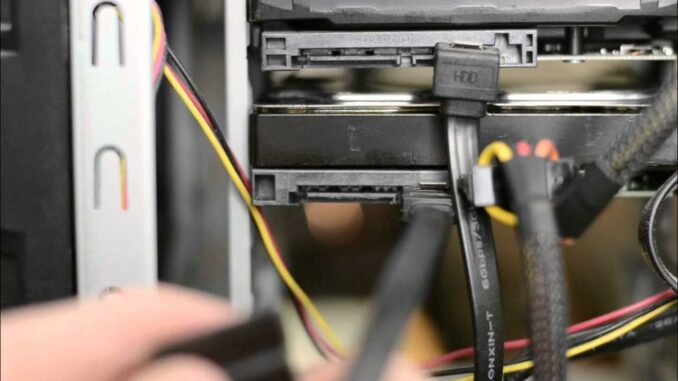
Introduction to Installing a Graphics Card
A graphics card is essential for rendering images, videos, and 3D graphics on your computer monitor. Whether you’re upgrading an existing GPU or installing a new one, the process involves physically inserting the card into a PCIe slot on the motherboard and connecting additional power cables if required. Here’s a detailed step-by-step guide on how to install a graphics card:
Preparation
Before you begin installing the graphics card, gather the necessary tools and components:
- Tools Needed:
- Screwdriver (typically Phillips-head)
- Anti-static wrist strap (recommended to prevent static discharge)
- Cable ties or Velcro straps (for cable management)
- Components Needed:
- Graphics card (ensure compatibility with your motherboard and power supply unit)
- Computer case with sufficient space and PCIe slots
- Power supply unit (PSU) with appropriate PCIe power connectors (if needed)
- Safety Precautions:
- Power off your computer and unplug it from the power source before handling any internal components.
- Ground yourself by wearing an anti-static wrist strap or touching a metal part of the case to discharge static electricity, which can damage sensitive electronics.
Step-by-Step Guide to Install a Graphics Card
Step 1: Prepare Your Computer
- Open the Case:
- Use a screwdriver to remove the side panel(s) of your computer case. Some cases have tool-less mechanisms for easier access to PCIe slots.
- Locate PCIe Slot:
- Identify an available PCIe x16 slot on the motherboard where the graphics card will be installed. This slot is usually longer than other PCIe slots and is used for graphics cards.
Step 2: Prepare the Graphics Card
- Remove Slot Covers (if necessary):
- Check the rear of your computer case for metal slot covers that align with the PCIe slot. Remove the appropriate slot covers to create space for the graphics card’s rear connectors.
- Unbox the Graphics Card:
- Carefully remove the graphics card from its packaging. Handle it by the edges to avoid touching the circuit board or components.
Step 3: Install the Graphics Card
- Align and Insert the Graphics Card:
- Hold the graphics card by its edges and align the connector edge (PCIe connector) with the PCIe slot on the motherboard.
- Gently but firmly press the graphics card into the slot until it is fully seated. Ensure the gold contacts are fully inserted into the slot.
- Secure the Graphics Card:
- Use the screws removed from the slot covers or retention mechanism provided by the case to secure the graphics card to the rear of the case. This prevents the card from sagging and ensures stability.
Step 4: Connect Power Cables (if necessary)
- Locate PCIe Power Connectors:
- Check the graphics card for additional power connectors, usually located on the top edge or side of the card.
- Connect the appropriate PCIe power cables from the power supply unit (PSU) to these connectors. Most modern graphics cards require one or two 6-pin or 8-pin PCIe power connectors.
Step 5: Cable Management
- Route Power Cables:
- Route PCIe power cables neatly along designated cable management channels or tie-down points inside the case. Use cable ties or Velcro straps to secure cables and prevent them from obstructing airflow or tangling with other components.
Step 6: Close Your Computer Case
- Secure Side Panels:
- Carefully close the computer case and secure it with screws or latches. Ensure all screws are tightened to prevent vibrations.
Step 7: Test and Configure
- Power On Your Computer:
- Plug your computer back into the power source and power it on.
- Install the latest graphics card drivers from the manufacturer’s website or using the included driver disc.
- Monitor Display Output:
- Connect your monitor cable (HDMI, DisplayPort, or DVI) to the video outputs on the graphics card. Verify that the monitor displays correctly and adjust display settings as needed in the operating system.
Step 8: Maintenance and Troubleshooting
- Regular Maintenance:
- Periodically update graphics card drivers to ensure compatibility with new games and applications.
- Clean dust buildup on the graphics card and inside the case using compressed air to maintain optimal performance.
- Troubleshooting:
- If you encounter display issues or instability, ensure the graphics card is securely seated in the PCIe slot and that power connectors are properly connected.
- Verify compatibility with your motherboard and PSU, and check for BIOS/UEFI updates if necessary.
Conclusion
Installing a graphics card enhances your computer’s visual performance for gaming, video editing, and other graphics-intensive tasks. By following this step-by-step guide and taking necessary precautions, you can successfully install a graphics card in your desktop PC.
Always refer to specific instructions provided by your graphics card manufacturer and motherboard manual for detailed guidance and compatibility information tailored to your hardware.